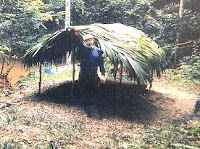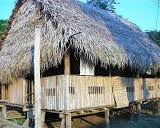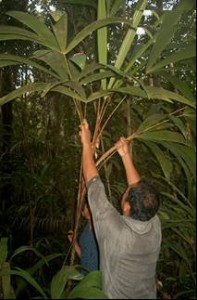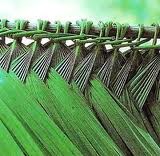The first thing I was taught by Gerineldo Moises Chavez, my jungle survival instructor, was how to build a tambo, a jungle hut. It wasn’t fancy, as you can see, but it kept me dry when it rained and kept me off the ground while I slept.
 |
| My first tambo |
In fact, all ribereño houses are built on exactly the same principles — a thatched house on stilts, built entirely of jungle materials, which may range in size from a small temporary hunting shelter, just large enough to sleep one or a few people, to an elaborate structure able to house an extended family.
Some of these houses are relatively isolated; some — connected together by footpaths through the jungle, or clustered about a central square — form caseríos, villages, with a soccer field, perhaps a cement schoolhouse and community center, even a clinic or a small bodega for goods brought upriver by motorized canoe.
 |
| A ribereño house |
Ribereño house construction is similar throughout the Upper Amazon. Both the thatched roof and the raised flooring are supported by upright posts made of durable hardwoods, usually huacapú (Minquartia guianensis), icoja (Unonopsis spp.), or tahuari (Tabebuia spp.). These hardwoods have acquired symbolic meaning in shamanism and plant medicine: their bark is used in medicines to enhance male potency, and is added to the ayahuasca drink to support those who drink it, just as these trees support the ayahuasca vines that climb their trunks.
The roof is thatched with irapay palm leaves (Lepidocaryum tessmannii), whose stems are looped and knotted on poles of pona wood (Socratea exorrhiza) to form long sheaves, called crisneja, that are then tied in an overlapping pattern onto the rafters with strips of atadijo bark (Trema micrantha) — the same bark that is used to bind the long cylindrical bundles of cured tobacco sold in the market. The peak of the roof is covered with yarina palm leaves (Phytelephas spp.), and the springy floor — it bounces when you walk on it, which can be disconcerting at first — is made of slats cut from the trunk of the huacrapona palm (Iriartea deltoidea). Ethnobotanist James Duke estimates that as many as twenty different species of plants may be used in the construction of a single dwelling.
 |
| Huacapú — uprights |
There is usually a single primary room, where people sleep under mosquito nets, either on the floor or in hammocks; bedding and nets are rolled up during the day. There may be a separate storeroom, or a separate sleeping room for the older members of the household. Supplies and equipment are also kept up in the rafters that support the thatched roof. The kitchen is often separated from the main house, at ground level, or connected with the main house by an elevated walkway, with a thatched roof for cooking when it rains. A notched tree trunk provides steps to the main room; there may be a railing around the front of the elevated room, forming a porch, from which residents talk to passers-by.
 |
| Irapay — roof thatch |
So: There is a family room, perhaps a bedroom or storage room, and a kitchen. Where’s the bathroom?
When I was living in the jungle hut of don Rómulo Magin, trying to learn the medicine, I would get up on shaky legs to vomit at the edge of the clearing. The next morning, embarrassed, I would go to look at the mess I had made, and find that everything was gone. The jungle had recycled it.
 |
| Pona — thatch crossbeams |
One day, I decided to experiment. I defecated at the edge of the jungle, and waited to see what would happen. Metallic flies immediately started to swoop around my leavings, and small dung beetles converged and began eating, the females laying eggs in the warm scat. Then larger dung beetles arrived and began rolling up small balls of dung — gifts for their lady friends, who mate with the male who brings the largest present, and deposit the fertilized eggs into the ball of dung, which the couple then bury together. Other beetles burrowed under the mound to eat the smaller beetles; large centipedes came rushing up to get their share. For some reason — perhaps its high potassium or protein content — human scat is greatly prized by small jungle creatures. More than fifty species of dung beetle may converge on a human pile. Within half an hour, everything I had left on the ground was gone.
 |
| Crisneja — irapay leaves looped on a pona pole |
That is one of the reasons there is no humus on the jungle floor. Humus — dirt — takes hundreds of years to accumulate. In the jungle, everything is recycled much too quickly to form dirt. This lack of soil is why tall jungle trees fall over so frequently; you can hear the sharp cracks of falling trees while lying in your hammock. Treefall is one of the primary ways in which the jungle renews itself.
You get used to this instant recycling. One of the problems with living in the jungle for many generations is that you assume that the jungle cleans itself, which is largely true. But this attitude creates some problems. One of the problems can be found on the beautiful Pacific beaches in Lima, which, even in the fanciest neighborhoods, are covered with garbage. Another problem is potable water.
 |
| Yarina — roof peak |
In the jungle there are few latrines. Many people go out into the jungle to defecate, or squat in the water at the edge of the river; many houses on stilts on the river’s edge have tiny rooms with a hole in the floor directly over the water. I have seen people bathe and wash dishes downstream from where they defecate. Even when ventilated concrete latrines have been constructed, they are often not well maintained and, when full, abandoned. Many larger river boats have a small screened room sticking out over the water with a hole in the floor. Clean drinkable water remains a significant need in many ribereño communities.

- Previous Post: Soul Ayahuasca
- Next Post: The Natufian Shaman
- More Articles Related to: Indigenous Culture, Jungle Survival, The Amazon



Tambos are very similar to the Seminole Chickees